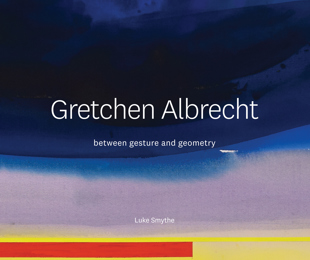Martin Edmond has reviewed the revised edition of Gretchen Albrecht: Between gesture and geometry by Luke Smythe on ReadingRoom:
‘In the European tradition, at least since Giorgio Vasari’s Lives of the Most Excellent Painters, Sculptors, and Architects (1550; 1568), more commonly known as The Lives of the Artists, there has been a fascinating interplay between those who make art and those who write about it. Vasari, for instance, was accused soon after the publication of the first edition of his book of favouring the artists of Florence over those of Venice; and his attempts to redress the perceived imbalance in the second edition were considered by most readers perfunctory and unconvincing. He remained a partisan of his own home town, as writers so often do. Artists too. The rights and wrongs of that ancient quarrel aren’t my concern here; but the ways in which writers pair up with artists is, and also how they write about them.
There have been many combinations of artists and writers over the last hundred years or so. Some, like the friendship of Paul Cézanne and Émile Zola, ended badly. Others, like the partnership between Max Beckmann and Stephen Lackner, benefited both parties and left no acrimony behind. In twentieth century New Zealand we have the example of Colin McCahon and Gordon Brown; and, more obscurely, Allen Maddox and Tony Green. These were relationships between near contemporaries; another kind is that between a younger writer and an older artist: Francis Pound on Gordon Walters. That is also an example of the living writer/dead artist dynamic, as is the recent Greg O’Brien book about Don Binney. It shouldn’t go unremarked that these are all male/male pairings. Female/female ones, like Jill Trevelyan and Rita Angus, or Mary Kisler and Frances Hodgkins, are less common. Male/female or female/male are much more rare; but that is what we have here.
Luke Smythe began cataloguing Gretchen Albrecht’s oeuvre in the late 1990s. It took him about five years and laid the groundwork for the volume under review; which is a revised and expanded version of a book of the same title, published by the same publisher, under a different cover, in 2019. The additions here relate to a hitherto neglected series, Illuminations, referencing Rimbaud, from the late 1970s; and the work Albrecht has produced since 2018. The last section of the book, ‘Time’s Measure’, covers the years 2019-2023 and includes a major series, ‘Eight Hours’, made between 2019-21. These were the lockdown years and the text explores ways in which the restrictions affected the work the artist was able to do. It is perhaps unusual for a revised work to appear so soon after the original publication and no reasons are given as to why this was done. Perhaps it is just because the earlier version sold out.
Smythe is a New Zealander who has worked in the US and Germany (he is about to publish a book on Gerhardt Richter) and now teaches in the Faculty of Art Design and Architecture at Monash University in Melbourne. He must have been quite young, perhaps still a student, when he began cataloguing Albrecht’s work. And, it turns out, he first visited Albrecht’s studio many years before that, in the early 1980s, in the company of his parents, who were thinking of buying a work — which they did, he says, acting upon his childish recommendation; and still have it on their walls of their house today.
The Albrechts are also a tight knit family. For a long time Gretchen’s father made the stretchers for her canvases; when he retired towards the end of the 1980s, the work was taken over by her brother, who makes them still. She is married to James Ross, a fine painter in his own right and also a formidable organiser, curator and networker, both in New Zealand and internationally. With Gretchen’s son, Andrew, from an earlier marriage, he is one of the two dedicatees of Smythe’s book; but the part he has played in his wife’s career is not a focus of the text. This is not a criticism; I’m sure the decision to leave him mostly out of things was deliberate and made for good reasons.
That leaves the pairing of Gretchen Albrecht and Luke Smythe, the artist and the writer. Smythe’s text is chronological; the biography of the artist figures in the narrative, with the significant events of her life noted and sometimes related to a concurrent work, but his interpretations don’t rely upon biographical information as such. Rather, his approach is formal and thematic: he is concerned to relate Albrecht’s work to the currents of art history, in terms of recent practice in abstract art and more traditional art historical sequences — as far back as some of the Florentine artists Vasari wrote about in the sixteenth century. Indeed, the foreword to the book, by Mary Kisler, has she and Albrecht wandering around Florence together in the spring of 1992. Smythe is also very much concerned with what the paintings mean.’
Read the full review here.


